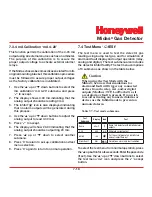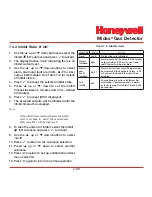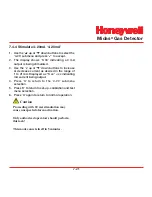
Midas
®
Gas Detector
9-3
To maintain sensor accuracy when using the
pyrolyzer, perform a gas calibration every six
months. Do not allow the ambient temperature at
the point of installation to exceed 40°C (104°F).
Operation above this temperature may require
more frequent bump testing or calibration to
confirm working specification. Because of the
higher operating temperatures when using the
pyrolyzer module, Honeywell Analytics strongly
recommends that the ventilated Midas Top
Cover (part number MIDAS-A-039) be used in all
pyrolyzer applications.
NOTE: The Pyrolyzer module is serviceable only
by trained personnel or by Honeywell Analytics’
Service Center. Inappropriate handling can cause
injury and device damage.
Note: Le module pyrolyzer pouvant-être réparé.
Par contre la réparation doit-être effectuée par
un personnel qualifié ou à un centre de service
autorisé d’Honeywell Analytics. Une manutention
inadéquate pourrait causé des blessures ainsi que
des dommages à l’appareil.
Diagram 9-2 shows the main components of the
pyrolyzer.
Diagram 9-2. Pyrolyzer components.
Diagram 9-2. Pyrolyzer components.
Diagram 9-3 shows in a simple form how a gas
sample is drawn through the pyrolyzer module by
the pump (located at the end of the gas path). It
is first routed to the pyrolyzer via the Freon filter
before being sent to the gas sensor cartridge,
where the gas measurement is taken. The sample
continues via the flow meter through the dust
filter and is finally exhausted from the instrument.
Adjustment of the gas flow through the instrument
is done automatically. It is recommended to
perform a leak check (see
Section 8.5
) before
performing a flow calibration. To perform a flow
calibration refer to
Section 7.3.3
.
Diagram 9-3. Pyrolyzer configuration gas flow.
Pyrolyzer Heater
Pyrolyzer
Gas sample
Inlet
Gas sample
Exhaust
Pump
Freon
filter
Pressure sensor
Orifice
(Bypass flow)
Gas sensor
Laminar flow element
(Flow measurement)
Needle Valve
(Heater flow adjustment)
Note: Model 0P-3
does not require
flow adjustment.
Summary of Contents for Midas
Page 7: ...Midas Gas Detector 1 1 1 Description ...
Page 9: ...Midas Gas Detector 2 1 2 Overview ...
Page 14: ...Midas Gas Detector 3 1 3 Default Configuration ...
Page 17: ...Midas Gas Detector 4 1 4 Installation ...
Page 41: ...Midas Gas Detector 5 1 5 Startup ...
Page 43: ...Midas Gas Detector 6 1 6 Operation ...
Page 53: ...Midas Gas Detector 7 1 7 Navigating Modes and Submenus ...
Page 74: ...Midas Gas Detector 8 1 8 Maintenance ...
Page 82: ...Midas Gas Detector 9 1 9 Pyrolyzer Module Options ...
Page 89: ...Midas Gas Detector 10 1 10 Optional LonWorks Interface Installation ...
Page 99: ...Midas Gas Detector 11 1 11 Troubleshooting and Fault Diagnosis ...
Page 102: ...Midas Gas Detector 12 1 12 REFLEX ...
Page 104: ...Midas Gas Detector 13 1 13 Internal Web Server ...
Page 106: ...Midas Gas Detector 13 3 Diagram 13 1 IPAddress setting in Windows XP ...
Page 129: ...Midas Gas Detector 14 1 14 Typical Installation Topologies ...
Page 132: ...Midas Gas Detector 15 1 15 Ordering Information ...
Page 136: ...Midas Gas Detector 16 1 16 Specifications ...
Page 139: ...Midas Gas Detector 17 1 17 Calibration and Bump Testing ...
Page 143: ...Midas Gas Detector A 1 A Modbus TCP Interface ...
Page 150: ...Midas Gas Detector B 1 B Gas Tables ...
Page 158: ...Midas Gas Detector C 1 C Warranty ...












































